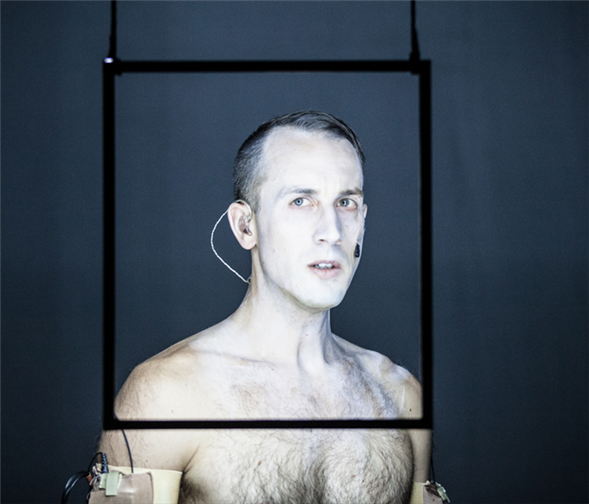Translate Page

The profoundly human technology of YOUARENOWHERE
---
Multimedia artist Andrew Schneider's first love isn't technology; it's performance. In fact, he was trained as an actor and later taught himself how to create videos. "In grad school, I was the performer who was trying to do tech," he recalls. Later, however, when he was hired to create video for Wooster Group shows, he became known as, in his words, "the tech guy who kind of wanted to perform."
But in his first full-length production as an independent artist, YOUARENOWHERE, Schneider is fulfilling both roles in equal measure.
The title of YOUARENOWHERE, at 3LD Art & Technology Center through April 3, can be interpreted in two ways: "You are nowhere" and "You are now here." Matching that ambiguity, the show has no traditional narrative. Instead, it's an existential meditation on quantum theory, human connections, and alternate realities.
That sounds like heady stuff, but Schneider keeps it interesting. He performs the entire hour-long monologue shirtless, wearing white face makeup, black slacks, and sensors on his biceps.
"I'm not good at telling a story," Schneider says, adding that he wanted to focus on "sharing experience rather than sharing a story." So far, so good. After playing last year at the COIL Festival, YOUARENOWHERE earned Schneider an Obie, and it has since earned rave reviews everywhere from Australia to France to Slovenia.
What's made the show a must-see is the novel way Schneider incorporates multimedia. Instead of having a technician run cues, Schneider makes his own body the control panel, so that his voice and movement sometimes control the light, sound, and video effects. At one point, a line Schneider's speaking will be recorded live and then replayed backwards. At other times, his head will disappear but his body will be illuminated. And then there's a big effect that comes midway through the show. No spoilers, but suffice to say that it's all in service of playing with the audience's perception of space, time, and reality.
Schneider traces his fascination with wearable technology to grad school. He has a master's degree from NYU in Interactive Telecommunications, and he has made a number of devices that respond to movement, such as a camera that takes a selfie every time the viewer blinks. "I find it very pleasing when video, sound, and lights are on the same page as text and movement," he says. "So when you can change everything at the same time, like the exact same time, there's a sort of synesthesia that occurs. So if you're wearing sensors, if you gesture and something happens, you made it happen. lt's not like someone's pressing a light at the same time. You're the one actually doing that. The hyper-precision of timing of that is experiential rather than a design thing."
{Image1}
Schneider says he's basically playing a heightened version of himself in this piece. Or as he phrases it, "There is a plug in my brain and someone, like, plugged a thing in there, you know?" He also understands if audiences become overwhelmed by the barrage of things that he's saying. "It's too fast. It's meant to be a texture. At a certain point, it's meant to wash over you, and you can pick out certain things here and there."
Ideally, the overall experience will demonstrate how humans and technology can function more harmoniously, so that tech becomes a method to engage with another person, rather than a self-isolating mechanism. "If I can't move people with narrative, I feel like I can move people with the culmination of experience," Schneider says. "So I started in on this concept of curating emotion without narrative. That's like what music does, or what concert lighting does, or visual art. So now I try to use technology to do that."
Still, having a show this tech-heavy, controlled by body sensors and a laptop, does have its downsides: things have broken. During a performance at COIL, the house lights went up prematurely and ruined the ending.
"So I just had to stand up and be like, 'You're not going to believe this; the show is over," Schneider recalls. "'Our nonexistent light board broke. No one knows how to fix this, and thank you very much.' And I was devastated!"
Afterwards, he saw a kind of grace in the mishap, recalling something that his team said to him: "'All of the technology broke and it was just you, and it was just them, and that was it! You were actually just in a room together at the end of the day, which is really nice.'"
---
Follow Diep Tran at @DiepThought. Follow TDF at @TDFNYC.
Photos by Maria Baranova.
TDF Members: Go here to browse our current discounts for theatre, dance, and concerts.